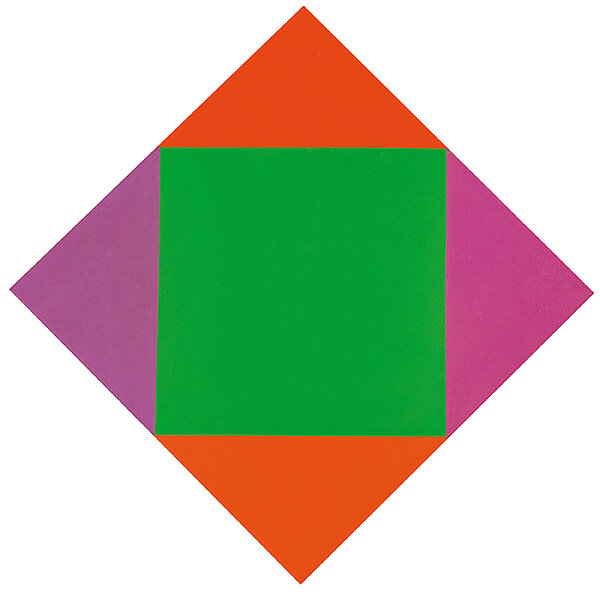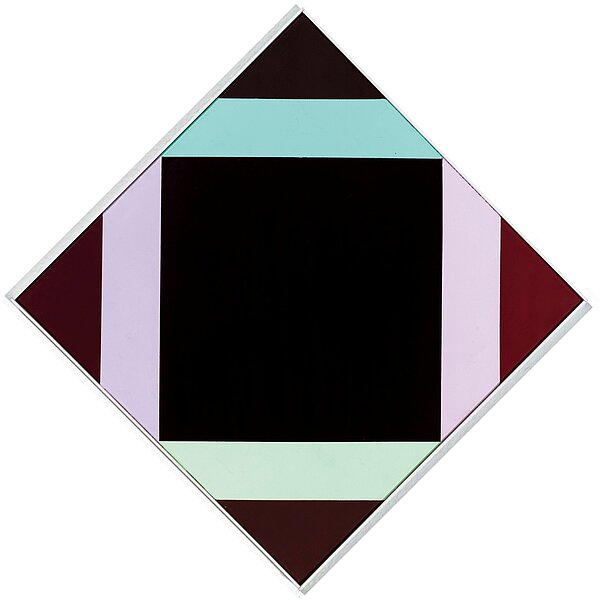Max Bill
strahlung aus grün, 1959/66
Oil on canvas
47 x 47 cm
© VG Bild-Kunst, Bonn 2022
Photo: Gerhard Sauer
Max Bill
transcoloration durch helle zonen, 1972/73
Oil on canvas
88 x 88 cm
© VG Bild-Kunst, Bonn 2022
Photo: Gerhard Sauer
Swiss-born Max Bill is internationally regarded as one of the foremost representatives of concrete art. His reputation is largely as a painter, but throughout his life he has created numerous sculptures and designed a number of buildings, including the complex of the Hochschule für Gestaltung in Ulm founded in 1950. In addition he has taught at a variety of colleges, worked as a publicist and art theorist, and for many years been politically active.
Max Bill has moulded our notions of concrete art as has no other artist through his own works and writings. As a student at the Bauhaus in Dessau in the late 1920s, he was particularly impressed by the works of Piet Mondrian, László Moholy-Nagy, and other of their fellow Constructivists. In 1935 he took up the idea of concrete art, as coined by Theo van Doesburg in contradistinction to abstract painting, and delineated it more precisely by basing it on mathematical laws and organizing principles. Subsequently the scientific, analytic approach advanced by Max Bill fell on extremely fertile soil in Switzerland: Zurich saw the formation of the so-called Zurich Concretists, a small circle of artists who largely employed serial and modular methods and only produced geometrical paintings. Apart from Max Bill, the main representatives of this circle included Camille Graeser, Verena Loewensberg, and Richard Paul Lohse. As a prominent counterposition to expressive, gestural or Tachist painting, the Zurich Concretists with their extreme emphasis on objectivity and rationalism attracted international interest. Max Bill adhered to the idea of concrete art right until the end of his life, although in later years he came to view the mathematical methods for creating concrete shapes and images, which previously he had adamantly insisted on, as simply a necessary part of a broader process.
The two oil paintings in the Marli Hoppe-Ritter Collection are part of a series the artist commenced in 1964, consisting entirely of paintings set at an angle. Both works captivate by the carefully considered harmony of their structures and colours. The composition of these works, referred to by Max Bill as “pointy paintings”, generally develops from the basic form of the square, as is the case with the present two paintings. Each has a square at the centre that fits exactly into the lozenge-shaped canvas. With its stringent statuariness, the central squares constitute a harmonious counterweight to the uncustomary format of the canvas.
The intensity of the colours in strahlung aus grün chiefly derives from the use of pure and simple combination colours, as well as from the flickering effect that strong colour contrasts have on the eye. A square in rich green dominates the centre of the picture, while brilliant red and violet triangles augment it on the sides to form a regular diamond shape, almost giving the impression that the equilateral triangles hadve been folded out from the central square. The result is a composition that is as regular in shape as it is charged with energy, and that acts as a powerful signal.
The painting transcoloration durch helle zonen draws its specific appeal from a finer nuanced colour scheme and a subtler use of colour contrasts. Physically central to this work is a black square, framed by coloured bars in delicate shades of green and pink. Equilateral triangles in black and a dark reddish combination colour form the painting's four corners. Max Bill succeeds in this composition in exploiting the dark-pale contrast effect to the full. The pastel coloured bars seem to act as a surrounding frame for what is almost a view into a black void. Both the sensitive colour contrasts as well as the painting's balanced proportions and compositional structures lend the painting a calm, meditative effect. (Barbara Willert)
Max Bill
1908 born in Winterthur
1994 died in Berlin



